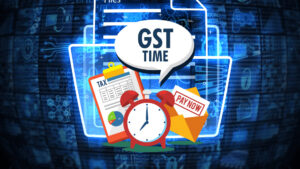-
- Calculation of IGST, CGST, and SGST
The calculation of IGST, CGST, and SGST involves applying the tax rate on the taxable value.
a) IGST Calculation: For interstate transactions, the IGST is calculated by applying the applicable tax rate on the taxable value. The entire IGST amount goes to the central government, which then shares the revenue with the destination state.
b) CGST Calculation: For intra-state transactions, the CGST is calculated by applying the applicable tax rate on the taxable value. The revenue from CGST goes to the central government.
c) SGST Calculation: For intra-state transactions, the SGST is calculated by applying the applicable tax rate on the taxable value. The revenue from SGST goes to the respective state or union territory government.
-
- Calculating Actual Profit after GST on Sales
To calculate the actual profit after GST on sales, you need to deduct the GST paid on purchases from the GST collected on sales. The formula is as follows:
Actual Profit = Sales – GST collected on Sales – GST paid on Purchases
The GST paid on purchases is treated as an input tax credit, which can be utilized to offset the GST liability on sales. The net GST liability is the difference between the GST collected and the input tax credit.
-
- What happens to GST paid while buying goods by customers?
When customers purchase goods, they pay GST as part of the total price. The GST paid by customers is collected by businesses and eventually remitted to the government. It serves as an input tax credit for the businesses against their GST liability.
-
- Benefits of GST to Businesses
a) Simplified Tax Structure: GST replaced multiple taxes, such as central excise, service tax, VAT, etc., with a single tax. This simplified tax structure reduces the compliance burden on businesses.
b) Increased Efficiency: GST eliminates the cascading effect of taxes, resulting in a more efficient tax system. Businesses can claim input tax credits, reducing the overall tax burden.
c) Uniform Taxation: GST creates a unified national market by streamlining tax rates and regulations across states. This enables businesses to operate seamlessly throughout the country.
d) Reduced Logistics Costs: GST eliminates entry tax and octroi, reducing the time and cost involved in interstate movement of goods. It promotes a more efficient supply chain and lowers logistics costs.
e) Improved Competitiveness: GST removes tax barriers, creating a level playing field for businesses. It encourages healthy competition, fosters economic growth, and promotes ease of doing business.
Conclusion
Understanding the fundamentals of GST, its calculation, and the difference between IGST, CGST, and SGST is crucial for businesses operating in countries where GST is implemented. By comprehending how GST affects profitability and utilizing the input tax credit, businesses can optimize their operations. Moreover, the benefits of GST, such as simplified tax structure, increased efficiency, and improved competitiveness, make it a significant reform for businesses and the economy as a whole.
Date of Enforcement: 23 March 2023
The Goods and Services Tax (GST) is a comprehensive indirect tax system implemented in many countries, including India. It revolutionized the taxation structure by replacing multiple taxes with a single tax, making it easier to understand and administer. In this blog post, we will explore what GST is, how it is calculated, the difference between IGST, CGST, and SGST, how to calculate actual profit after GST on sales, and the benefits of GST to businesses.
H1 Josefin Sans 22 Weight 600
Poppin Font SIze:16 Black Color
What is GST?
GST, or Goods and Services Tax, is a value-added tax levied on the supply of goods and services. It is a destination-based tax system where taxes are levied at each stage of the supply chain. The objective of GST is to create a seamless nationwide market by eliminating the cascading effect of taxes.
How is GST Calculated?
GST is calculated on the value added at each stage of the supply chain. The GST calculation involves applying the applicable tax rate on the taxable value. The taxable value is the price of the goods or services excluding GST. For example, if the tax rate is 18% and the taxable value of a product is Rs 100, the GST would be Rs 18.
Difference between IGST, CGST, and SGST
a) IGST (Integrated Goods and Services Tax): IGST is applicable when goods or services are supplied from one state to another or imported into the country. It is a combination of CGST and SGST/UTGST (State Goods and Services Tax/Union Territory Goods and Services Tax). The revenue generated from IGST is shared between the center and the destination state.
b) CGST (Central Goods and Services Tax): CGST is levied by the central government on intra-state supplies of goods and services. The revenue generated from CGST goes to the central government.
c) SGST (State Goods and Services Tax)/UTGST (Union Territory Goods and Services Tax): SGST/UTGST is levied by the state or union territory government on intra-state supplies of goods and services. The revenue generated from SGST/UTGST goes to the respective state or union territory government.
Poppin Font SIze:16 Black Color
Important Points Light Box
Poppin Font SIze:16 Black Color
Poppin Font SIze:16 Black Color
Poppin Font SIze:16 Black Color
H2 Tahoma 20 Weight 600
Poppin Font SIze:16 Black Color
Poppin Font SIze:16 Black Color
Poppin Font SIze:16 Black Color
Poppin Font SIze:16 Black Color
H2 Tahoma 20 Weight 600
Poppin Font SIze:16 Black Color
Poppin Font SIze:16 Black Color
Poppin Font SIze:16 Black Color
H2 Tahoma 20 Weight 600
Poppin Font SIze:16 Black Color
Poppin Font SIze:16 Black Color
H2 Tahoma 20 Weight 600
Poppin Font SIze:16 Black Color
Poppin Font SIze:16 Black Color
Let us know your feedback on this article “” in the comments below 👇

Sunil Kumar Sah @DigitalSunilSah
Sunil is an E-commerce Seller, Blogger, YouTuber and Digital Marketer. He is a digital enthusiast and passionate about Online Selling. He loves sharing his knowledge and experiences on eCommerce in this blog and on his Hindi YouTube Channel “Ecommerce with Sunil” and the English Channel “Ecomsprint“




